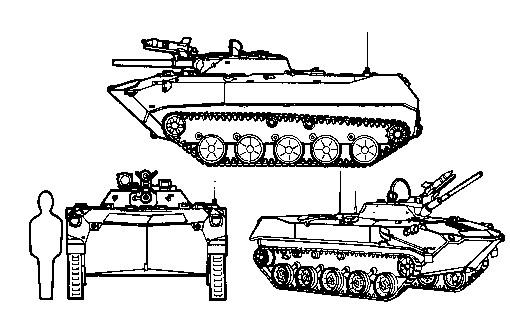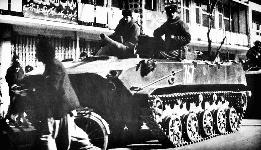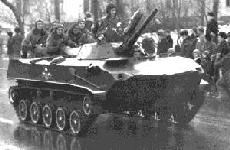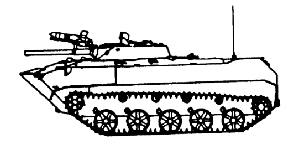





The BMD airborne amphibious infantry combat vehicle (AAICV) superficially resembles the BMP, although it is considerably smaller. The BMD-1 can be air dropped by parachute, and features a suspension that "squats" to fit into aircraft. It is a full-tracked amphibious vehicle with a BMP-type turret. Like the BMP, its main armament is a 73-mm smoothbore gun with a 7.62-mm coaxial machine gun mounted on the right side of the main gun and a SAGGER ATGM launcher mounted over the gun. The BMD, however, also has two additional 7.62-mm machine guns, one mounted in each of the front bow corners. The bow is much shorter than that of the BMP, and the upper part of the hull is shaped differently. It also differs from the BMP in having only five evenly spaced road wheels with four support rollers, and in having no rear exit doors. The driver's hatch and vision blocks are centered below the main gun. On either side of the driver, there is an additional hatch. The troop compartment has overhead armor cover and only one firing port on each side and one in the rear from which the mounted infantrymen can fire their personal weapons. The BMD has a hydro-pneumatic suspension with a variable height capability. The vehicle is powered by a rear-mounted, 240 hp, six-cylinder, water-cooled, diesel engines and is propelled in water by two waterjets in the rear.
The air-droppable BMD is considerably smaller and lighter than the BMP but has roughly the same capabilities. It is used in airborne divisions as an infantry combat vehicle. Its turret armor (maximum 25 mm) is thicker than that of the' BMP, but its hull is thinner (maximum 15 mm). An internal NBC filtration system provides protection for the three-man crew and four combat troops. Two squad members, including the squad leader, ride in the two hatch positions on each side of the driver, while the remaining three occupy the compartment between the turret and engine. The BMD is believed to have a maximum speed of 60 to 80 km/h on land and 10 km/h in water, with a land cruising range of 320 km.
Since the BMD has the same turret as the BMP, the turret armaments probably have the same limitations, except that the BMD does not have a dead space in its traverse. The passenger space is somewhat cramped, and the airborne soldiers must dismount over the sides of the vehicles, since there is no rear door.
The BMD was first seen in the Dvina exercise in the USSR in 1970 and was not seen again until the November 1973 Moscow Red Square parade. Since then, the BMD has replaced the airborne assault gun ASU-57 in the Soviet airborne forces, substantially increasing the firepower and maneuverability of the airborne division.
Although originally thought to be a light tank, the BMD may more properly be considered the airborne equivalent of the BMP infantry combat vehicle. However, except for the turret and main armament, it is an entirely new design and not a modified BMP. Excluding the obsolescent ASU-57, the BMD, at approximately 7.5 metric tons, was the lightest tracked combat vehicle in the Soviet Army.
Russian KBP offers a drop-in one-man turret, called Kliver, with a stabilized 2A72 30-mm gun, a 4-Kornet ATGM launcher, thermal sights, and improved fire control system. The Russian Volgorod Tractor Plant offers the B30 turret (a drop-in one-man turret with 2A42 30-mm gun, 7.62-mm coax MG, and a 9P135M launcher for AT-4/-5 ATGM). A Russian AG-17 30-mm automatic grenade launcher is available for BMD-1. Other options are spall liners, air conditioning, and a more powerful engine. A French SNPE explosive reactive armor (ERA) kit and others are available for use on the BMD-1. However, during dismounted troop movement, ERA would be a hazard. Thus, passive armor is more likely; and ERA application is doubtful. For amphibious use, additional armor application is unlikely. The Slovenian TS-M ATGM thermal night sight has a detection range of 4,500m and a recognition range of 2,000m. The AT-3 HE-Blast ATGM is used for killing personnel and destroying bunkers and other fortifications. The AT-3C Polk features a nose probe, an improved motor for increased velocity, lower smoke noise signature and a SACLOS launcher with improved sights.
Specifications | |
| Date of Introduction | 1969 |
| Proliferation | At least 1 country |
| Description | |
| Crew | 2 |
| Troop Capacity | 5 passengers (+1) |
| Combat Weight (mt) | 13.3 |
| Chassis Length Overall (m) | 6.74 |
| Height Overall (m) | 2.15 |
| Width Overall (m) | 2.94 |
| Ground Pressure (kg/cm 2 ) | 0.57 |
| Automotive Performance | |
| Engine Type | 240-hp Diesel |
| Cruising Range (km) | 600 |
| Speed (km/h) | |
| Max Road | 65 |
| Max Off-Road | 40-45 |
| Average Cross-Country | INA |
| Max Swim | 7 |
| Fording Depth (m) | Amphibious |
| Radio | R-123M |
| Protection | |
| Armor, Turret Front (mm) | 23 or Antibullet |
| Active Protective System | N/A |
| Mineclearing Equipment | N/A |
| Self-Entrenching Blade | N/A |
| NBC Protection System | Collective |
| Smoke Equipment | VEESS |
| ARMAMENT | |
| Main Armament | |
| Caliber, Type, Name | 73-mm smoothbore gun, 2A28/Grom |
| Rate of Fire(rd/min) | 7-8 |
| Loader Type | Autoloader |
| Ready/Stowed Rounds | 40 / 0 |
| Elevation (�) | -4/ +33 |
| Fire on Move | Yes, but only 10 km/h or less (est) |
| Auxiliary Weapons | |
| Caliber, Type, Name | 7.62-mm (7.62x 54R) machinegun, PKT |
| Mount Type | Coax |
| Maximum Aimed Range (m) | 1,300 |
| Max Effective Range (m) | |
| Day | 1,000/400-500 on the move |
| Fire on Move | Yes |
| Rate of Fire (rd/min) | 250 practical / 650 cyclic, 2-10 round bursts |
| Caliber, Type, Name | 7.62-mm machinegun, PKT |
| Mount Type | Bow (ball-mounted) |
| Maximum Aimed Range (m) | 1,000 |
| Max Effective Range (m) | |
| Day | 1,000/ 400-500 on the move |
| Night | N/A |
| Fire on Move | Yes |
| Rate of Fire (rd/min) | 250 practical / 650 cyclic, 2-10 round bursts |
| ATGM Launcher | |
| Name | 9P111 |
| Launch Method | Rail-launched |
| Guidance | MCLOS |
| Command Link | Wire |
| Launcher Dismountable | Yes |
| Firing Ports | 1 on each side, 1 in left rear door |
| FIRE CONTROL | |
| FCS Name | INA |
| Main Gun Stabilization | N/A |
| Rangefinder | Stadiametric |
| Infrared Searchlight | Yes |
| Sights w/Magnification | |
| Gunner | |
| Day | 1PN22M1, 8x |
| Field of View (�) | 15 |
| Acquisition Range (m) | |
| Night | 1PN22M1, 6.7x |
| Field of View (�) | 6 |
| Acquisition Range (m) | 800-1,000, based on light |
| Commander Fire Main Gun | No |
| MAIN ARMAMENT AMMUNITION | |
| Caliber, Type, Name | |
| 73-mm HEAT-FS, PG-9 | |
| Maximum Aimed Range (m) | 1,300 |
| Max Effective Range (m) | |
| Day | 800, but 600 or less on the move |
| Night | 800 |
| Tactical AA Range | INA |
| Armor Penetration (mm) | 335 (RHA) |
| 73-mm HEAT-FS, NFI | |
| Maximum Aimed Range (m) | 1,300 |
| Max Effective Range (m) | |
| Day | 1,000, but 600 or less on the move |
| Night | 800-1,000 |
| Tactical AA Range | INA |
| Armor Penetration (mm) | >400 (RHA) |
| 73-mm HE, OG-9 | |
| Maximum Aimed Range (m) | 1,300, 600 or less on the move |
| Max Effective Range (m) | |
| Day | 1,300, but 600 or less on the move |
| Night | 800-1,000 |
| Tactical AA Range | INA |
| Armor penetration (mm) | INA |
| 73-mm HE, OG-9M1 | |
| Maximum Aimed Range (m) | 4,500 |
| Max Effective Range (m) | |
| Day | 1,300, but 600 or less on the move |
| Night | 800-1,000 |
| Tactical AA Range | INA |
| Armor Penetration (mm) | INA |
| Other Ammunition Types | OG-9M |
| Antitank Guided Missiles | |
| Name | AT-3, -3A, -B |
| Warhead Type | Tandem HEAT |
| Armor Penetration (mm) | 410 RHA |
| Range (m) | 3,000 |
| Name | AT-3C |
| Warhead Type | Tandem HEAT |
| Armor Penetration (mm) | 520 RHA |
| Range (m) | 3,000 |
| Name | AT-3C Imp/ Polk (Slovenian) |
| Warhead Type | Precursor with HEAT |
| Armor Penetration (mm) | 580 RHA |
| Range (m) | 3,000 |
| Name | Malyutka-2 (Russian) |
| Warhead Type | Tandem HEAT |
| Armor Penetration (mm) | 800 RHA |
| Range (m) | 3,000 |
| Name | Malyutka HE (Russian) |
| Warhead Type | Frag-HE |
| Armor Penetration (mm) | N/A |
| Range (m) | 3,000 |




